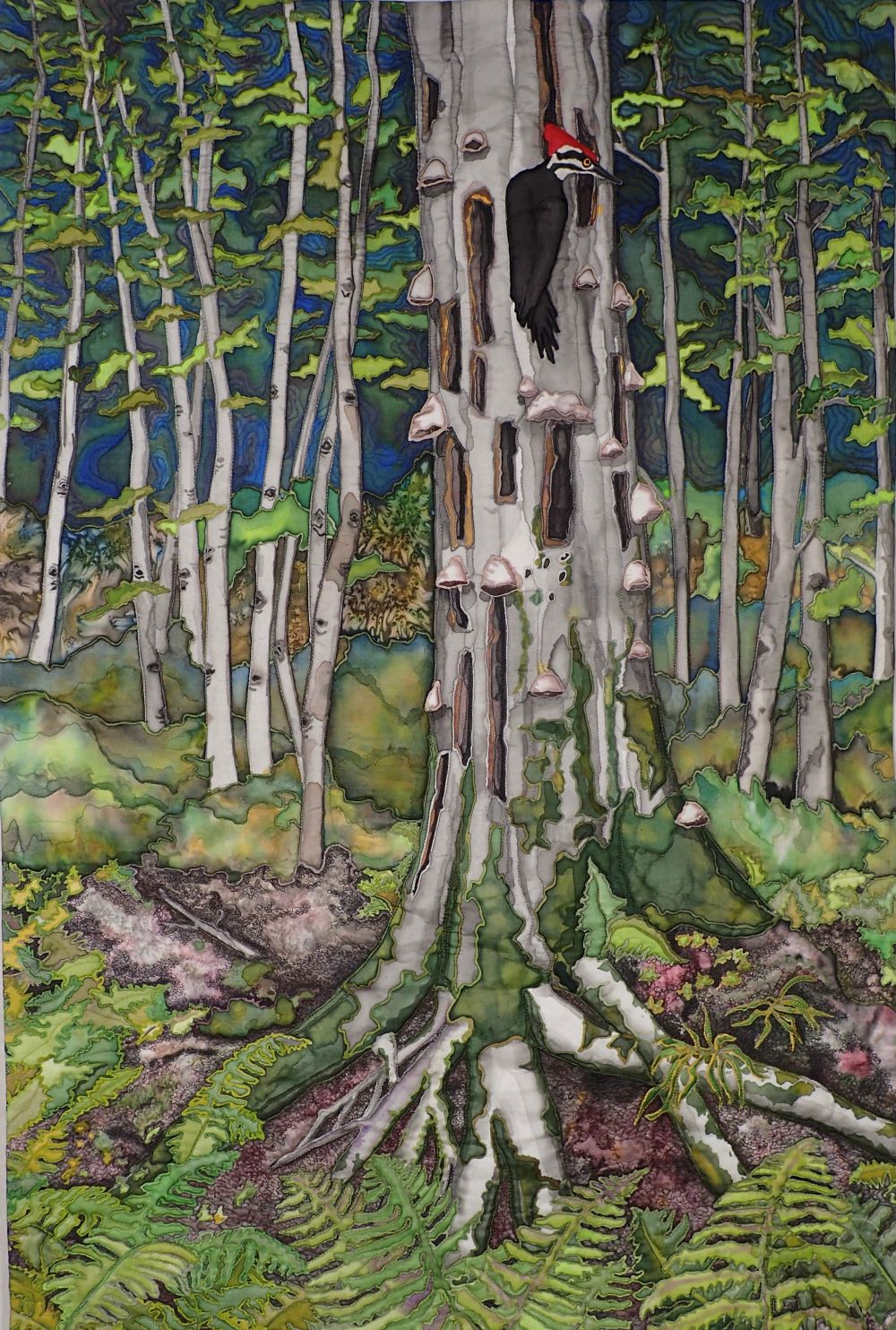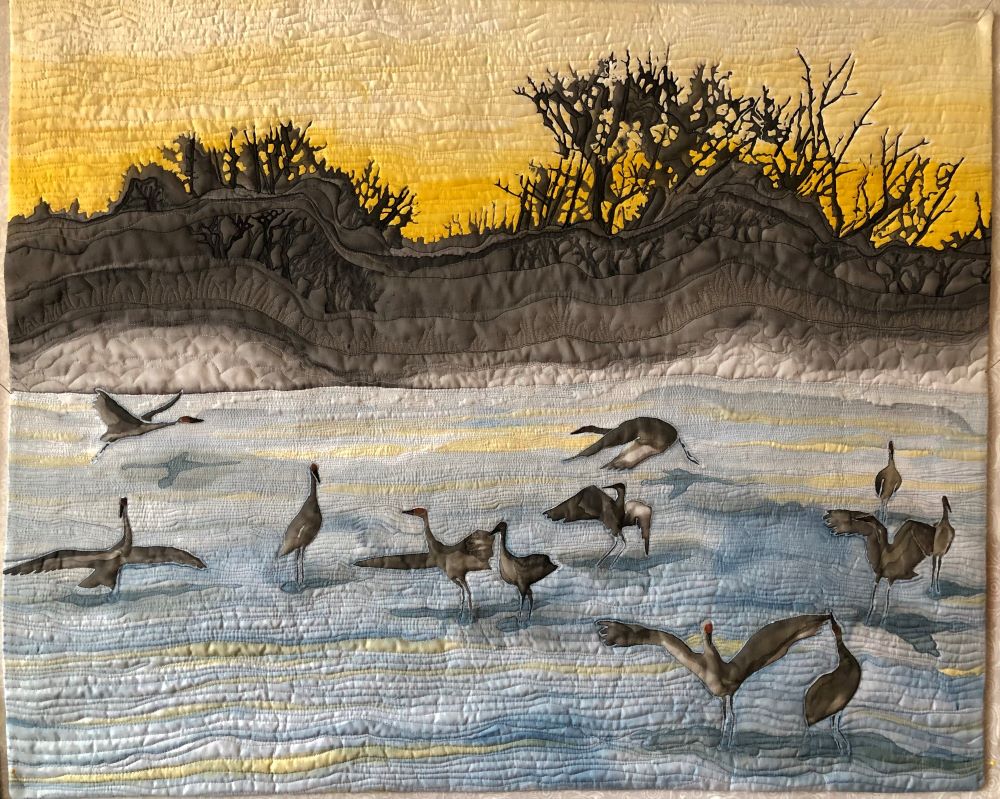Fiber Artist Marty Kotter Features in Sanctuary Quilt Exhibition

 By Sandy Libertini, Grange Insurance Audubon Center engagement manager
By Sandy Libertini, Grange Insurance Audubon Center engagement manager
Marty Kotter gathers joy and inspiration for her art from nature. She finds her subjects anywhere from her backyard to travels throughout the U.S. and abroad. Sanctuary will feature 50 pieces depicting safe places for wildlife in natural and human occupied settings on display at the Grange Insurance Audubon Center, May 4 – July 5.
Sandy: Tell us about your art. What prompted you to pursue fiber art?
Marty: I have always liked fiber and making pictures out of cloth. I like the colors, visual texture and feel, whether it is transparent or opaque, and how it reflects light. You can do so many things with cloth—fold, paint, dye, cut, layer, sew, stuff and quilt it. My quilts are art pieces made to hang on a wall.
I am a watercolorist. When I took classes in silk painting, I found the technique is much like watercolor. The finished painting is luminous and translucent. The quilting adds a 3D effect in giving it texture and contours. These two techniques combine to form my unique art quilts.
Sandy: What draws you to depict nature in your work?
Marty: In college, I studied biology and ecology. After a career as a public school teacher and a park naturalist, I am now pursuing art full time. I am drawn to wild places, from my garden to wilderness areas for inspiration. The ultimate goal of my art is to promote conservation and stewardship of the natural world.

The Gift, by Marty Kotter
Sandy: The name for your quilt exhibit at the Grange Insurance Audubon Center is Sanctuary. Why did you use this title?
Marty: Nature is my sanctuary from daily pressures and deadlines, even if it is only 10 minutes in the garden. My artist friend Deb Baillieul and I are collaborating on the Sanctuary exhibit at the Grange Insurance Audubon Center. Our thoughts for naming the exhibition brought up six definitions for the word including:
- A sanctuary for migrating birds is a stopover on a lake or river for rest that is safe from predators.
- A sanctuary is a backyard garden planted with native plants free from pesticides that harm the pollinators.
- A sanctuary is a pond where frogs, salamanders, turtles and fish can thrive.
- A sanctuary can be as small as an empty lot, an alley or a narrow greenway along a river.
- A sanctuary is a national park where wildlife can thrive, and humans can visit.
- A sanctuary for people is a safe place free from worry, free from war and safe from threats and crime.
Sandy: You have had several artist residences in the last few years. What attracts you to these residences?
Marty: Since 2019, I have had four different artist residencies in state and national parks. These residencies provided me with housing, sometimes without plumbing or electricity. It can be a joy to be unplugged. That allows artists to immerse themselves into nature to explore and make art without interruptions. Every day something amazing will happen, like an eagle flying over the lake or a loon calling. These events can turn into subjects for my art pieces. I am never short on subject material. At the conclusion of these residencies, I usually donate one piece of artwork to the park and give a presentation.

Daybreak at the Platte River, by Marty Kotter
Sandy: What is the best thing about the Columbus art scene right now?
Marty: There is an abundance of opportunities for people of all ages to explore and enjoy art in Columbus. As an adult, I have taken weaving, surface design and workshops at the Columbus Cultural Arts Center. Also, for over 30 years, the Quilt Surface Design Symposium has been held in Columbus, bringing in international faculty and students from all over the country to attend. Additionally, recreation centers in Columbus and the suburbs offer art classes in most mediums for youth and adults.
Sanctuary is on display free of charge at the Grange Insurance Audubon Center, 505 W. Whittier St., May 4 through July 5 during Center operating hours. Exhibition pieces are for sale with a portion of the proceeds benefiting the Grange Insurance Audubon Center and the work they do to preserve and protect the places birds and wildlife need today and tomorrow.
This article is part of a bi-weekly column brought to you by the Greater Columbus Arts Council as part of the Art Makes Columbus campaign. Explore a calendar of events, public art database and artist stories at columbusmakesart.com. To learn more about GCAC grants visit gcac.org.

